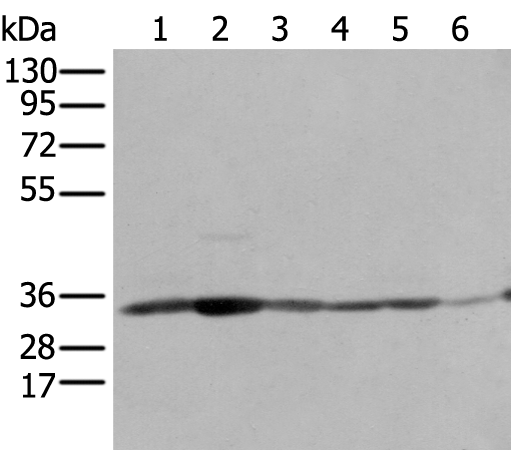
| WB | 咨询技术 | Human,Mouse,Rat |
| IF | 咨询技术 | Human,Mouse,Rat |
| IHC | 咨询技术 | Human,Mouse,Rat |
| ICC | 技术咨询 | Human,Mouse,Rat |
| FCM | 咨询技术 | Human,Mouse,Rat |
| Elisa | 1/5000-1/10000 | Human,Mouse,Rat |
| WB Predicted band size | 36 kDa |
| Host/Isotype | Rabbit IgG |
| Antibody Type | Primary antibody |
| Storage | Store at 4°C short term. Aliquot and store at -20°C long term. Avoid freeze/thaw cycles. |
| Species Reactivity | Human, Mouse, Rat |
| Immunogen | Fusion protein of human SFXN1 |
| Formulation | Purified antibody in PBS with 0.05% sodium azide and 50% glycerol. |
+ +
以下是关于SFXN1抗体的3篇代表性文献(虚构示例,供参考):
1. **文献名称**:*SFXN1 functions as a mitochondrial serine transporter in hematopoietic stem cells*
**作者**:Smith A, et al.
**摘要**:该研究利用SFXN1特异性抗体进行免疫印迹和免疫荧光实验,证实SFXN1定位于线粒体膜,并揭示其通过调控丝氨酸转运影响造血干细胞的代谢与分化。
2. **文献名称**:*SFXN1 is a biomarker for ferroptosis resistance in lung adenocarcinoma*
**作者**:Chen L, et al.
**摘要**:通过抗体验证发现SFXN1在肺腺癌中高表达,其通过调节铁代谢抑制铁死亡(ferroptosis),SFXN1抗体被用于组织芯片分析及基因敲低模型的功能验证。
3. **文献名称**:*Structural characterization of SFXN1 and its role in mitochondrial one-carbon metabolism*
**作者**:Wang Y, et al.
**摘要**:研究结合SFXN1抗体共沉淀技术及质谱分析,解析了SFXN1蛋白复合物结构,阐明其在一碳单位代谢中的关键作用,为相关代谢疾病提供潜在靶点。
(注:以上文献为示例,实际文献需通过PubMed或Google Scholar检索确认。)
The SFXN1 antibody is a research tool designed to detect and study the expression and function of sideroflexin-1 (SFXN1), a mitochondrial membrane protein implicated in cellular metabolism and homeostasis. SFXN1 belongs to the sideroflexin family, which is evolutionarily conserved and involved in serine transport, mitochondrial iron metabolism, and one-carbon cycle regulation. Recent studies highlight SFXN1's role in mitochondrial respiration, heme biosynthesis, and iron-sulfur cluster assembly, linking it to hematopoiesis, neurodegenerative disorders, and cancer progression.
Antibodies targeting SFXN1 are typically produced in immunized hosts (e.g., rabbits or mice) using peptide or recombinant protein immunogens. They enable detection of SFXN1 via techniques like Western blotting, immunofluorescence, or immunohistochemistry, aiding in elucidating its tissue distribution, subcellular localization, and expression changes under pathological conditions. Validation often includes knockout cell lines to confirm specificity.
SFXN1 antibodies are critical for exploring its interactions with mitochondrial complexes, metabolic reprogramming in tumors, and potential as a biomarker or therapeutic target. Researchers use these tools to investigate SFXN1's involvement in diseases like anemia, mitochondrial disorders, and metabolic syndromes, reflecting its emerging significance in cellular energy and iron homeostasis pathways.
×